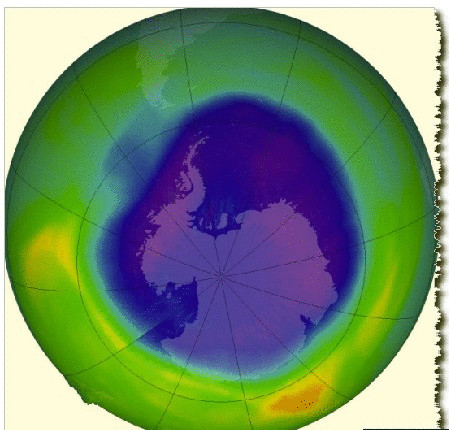The fragile layer of gas that protects all living things on Earth from the sun's harsh ultraviolet light is on the mend—in other words, the ozone hole is healing. That's according to the latest assessment by the World Meteorological Organization and the United Nations Environment Programme.
據(jù)世界氣象組織及聯(lián)合國(guó)環(huán)境規(guī)劃署的最新評(píng)估顯示:保護(hù)地球上所有生物免受太陽(yáng)紫外線照射的那層薄薄氣體正處于自我修復(fù)中——換句話說(shuō),臭氧層空洞正日漸變小。
The ozone hole had been growing for decades over Antarctica. But the world recognized the problem and took action more than a quarter-century ago. The 1987 Montreal Protocol phased out the use of chlorofluorocarbons, or CFCs, responsible. With the ozone-damaging compounds gone, the layer had a chance to recover and the hole is no longer growing.
幾十年來(lái),南極洲上空的臭氧層空洞在不斷擴(kuò)大。但早在25年前,人們就認(rèn)識(shí)到這一問(wèn)題,并采取了行動(dòng)。1987年的蒙特利爾議定書(shū)規(guī)定:分階段撤銷(xiāo)氯碳化物、氟氯碳化物、以及其他一些會(huì)對(duì)臭氧層造成破壞的物質(zhì)的使用。隨著破壞臭氧層化合物的減少,臭氧層得以自行修復(fù),臭氧層空洞的數(shù)量也不再增加。

the phase-out also helped slow global warming. Because CFCs are also powerful greenhouse gases. In fact, the agreement to address the ozone hole has actually cut five times the greenhouse gas emissions as has the Kyoto Protocol to address global warming.
該分階段計(jì)劃也令全球變暖的趨勢(shì)得以緩解。因?yàn)榉忍蓟锸菑?qiáng)大的溫室氣體。事實(shí)上,該蒙特利爾議定書(shū)(致力于解決臭氧層空洞問(wèn)題的)與京都協(xié)議書(shū)(以解決全球變暖為中心的)一拍即合——議定書(shū)的實(shí)施能使溫室氣體排放量降低五倍。
The Montreal Protocol shows that the world can come together to deal with global environmental problems. The protocol also illustrates that actions may require decades to yield results. Which drives home the need to address our climate crisis now.
該蒙特利爾議定書(shū)表明了:世界各地的人們可以團(tuán)結(jié)起來(lái),共同解決全球環(huán)境問(wèn)題。同時(shí),該協(xié)議還表明:有些問(wèn)題需要花上幾十年的時(shí)間才能解決。總而言之,我們現(xiàn)在就該好好解決下氣候危機(jī)問(wèn)題了。












